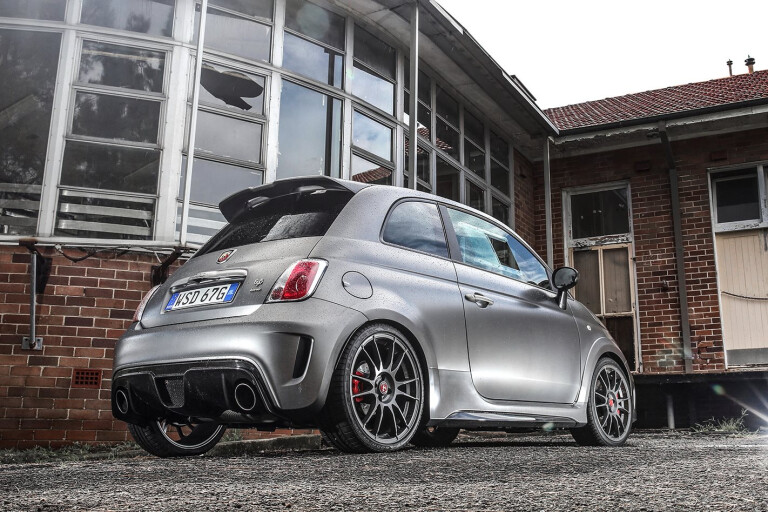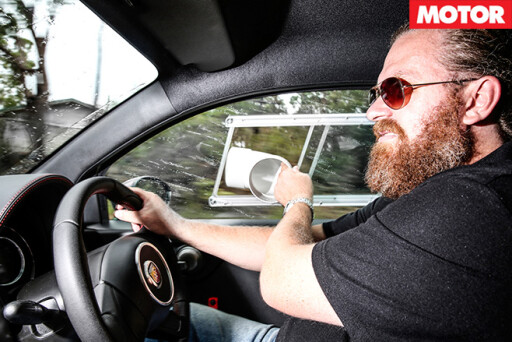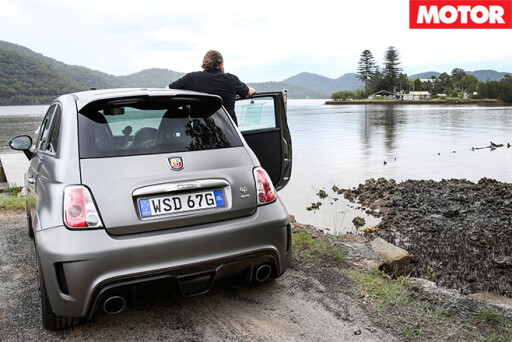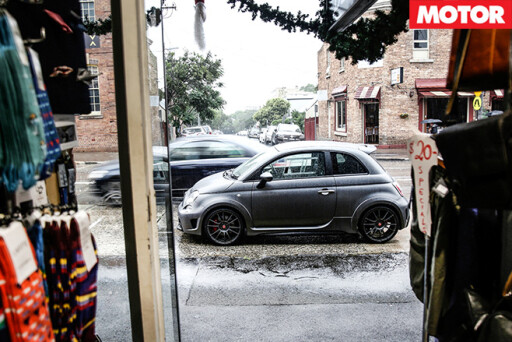
It used to be no fun being crazy.
Australia has a spotty history of locking up nutbags – Pentridge, Boggo Road, the Big Brother house – but down among the worst of the worst are two defunct insane asylums in Sydney: Callan Park in Rozelle and Peat Island at Mooney Mooney.
Both have some awful and tragic history buried – some of it literally – in their grounds; at Peat Island, one patient was locked in a steel container and left there until he died. Speaking of being locked in a tiny steel box made by crazy people, I’m feeling a bit like I might die myself.
We’re trundling the Abarth 695 Biposto through the damp remains of the Callan Park asylum. Biposto sounds like Italian for “going postal”, which would be apt for our horror-movie surroundings, but, in fact, it just means “two-seater”. (Does everything sound cooler in Italian? We’d take a Quattroporte over a Four-Door any day; maybe Proton should rename the Preve the Pica di Merda and see if it helps.)

The 695 has been more thoroughly stripped-out than a Queensland nickel company in an election year: the back seat is gone, replaced with a cargo net; there’s no radio; the interior door panels are just flat slabs with a cloth strip for a handle; even the air vents are just honeycomb grilles, to save the weight of the adjustable vanes. In fact, Abarth has produced such a bare-bones car that compared with the standard Fiat 500, total weight has gone from 900-odd kilos to… 997kg. Oh.
But the two things that are really noticeable right now are that the glass windows have been replaced with plastic with only tiny sliding apertures in them, which funnel a grand total of zero air into the cabin – and there’s no air-con. On a crisp winter morning that would probably be fine, but today – with the Sydney weather doing a creditable impression of Thailand’s steam-bath humidity and relentless rain – the Abarth is fogging up like a union boss’s memory.
 The stealth grey exterior looks right at home next to one of Callan Park’s abandoned wards. This sprawling complex hails from a time before society understood mental illness, and certainly before political correctness took over the nation – it was originally called the Callan Park Hospital for the Insane.
The stealth grey exterior looks right at home next to one of Callan Park’s abandoned wards. This sprawling complex hails from a time before society understood mental illness, and certainly before political correctness took over the nation – it was originally called the Callan Park Hospital for the Insane.
It was built in the 1870s as an overflow facility for the overcrowded Gladesville Hospital for the Insane, which begs the question of just how many crazy people there were in Sydney. Not as many, I suspect, as there are at the Abarth skunkworks.
Now it’s partly used for the Sydney College of the Arts – so, roughly the same clientele, then – and partly left to gently moulder away; a hodgepodge of grand old sandstone, red brick, broken glass, and the tangled remains of stripped-out wiring and plumbing. Most of the doors are sealed up with plywood; many of them carry warning signs about asbestos. The roofs bristle with lightning rods.
 In its heyday, Callan Park was a terrifying omen of One Flew Over The Cuckoo’s Nest – newspapers reported sadistic nurses whipping patients with studded leather straps and chaining the helpless souls in their care to the walls. Closer to a prison than a hospital, it was a place to dump and forget the city’s walking wounded. And the list of complaints that could get you stamped insane seems, itself, insane. The 1878 Lunacy Act lists “moral and physical causes” of insanity, including “domestic trouble”, “mental anxiety”, “love affairs and seduction”, “intemperance in drink”, “self-abuse”, and “sunstroke”. There but for the grace of God...
In its heyday, Callan Park was a terrifying omen of One Flew Over The Cuckoo’s Nest – newspapers reported sadistic nurses whipping patients with studded leather straps and chaining the helpless souls in their care to the walls. Closer to a prison than a hospital, it was a place to dump and forget the city’s walking wounded. And the list of complaints that could get you stamped insane seems, itself, insane. The 1878 Lunacy Act lists “moral and physical causes” of insanity, including “domestic trouble”, “mental anxiety”, “love affairs and seduction”, “intemperance in drink”, “self-abuse”, and “sunstroke”. There but for the grace of God...
Looking at it shrouded in rain, the asylum seems like a sad scar on the city. On the other hand, it’s a strangely apt setting for the 695. Both bear the marks of unhinged lunacy and, perhaps, gleeful sadism. Speaking of which, photographer Cristian and I have to get back into the sweat-box and start heading north to see if we can’t outpace the weather.
For an extra $15,000 – yes, ouch – you can get the 695 fitted with a race-spec dog ’box, which Fiat-Chrysler Australia claims is a first for a street-legal car; no synchromesh, which makes changing gears harder but faster.
 The dog ’box is quite the centrepiece, too. It’s an exposed mechanism that, whether or not it improves the driving, looks utterly, ridiculously cool. And once you have the engine wound up and some empty air in front of you it is brilliant, flicking between cogs blindingly quick with only the occasional grinding shriek to remind me that, no, I’m not a professional racer and never will be.
The dog ’box is quite the centrepiece, too. It’s an exposed mechanism that, whether or not it improves the driving, looks utterly, ridiculously cool. And once you have the engine wound up and some empty air in front of you it is brilliant, flicking between cogs blindingly quick with only the occasional grinding shriek to remind me that, no, I’m not a professional racer and never will be.
On the other hand, it’s a recalcitrant sonofabitch when you’re trundling along in heavy traffic. It’s the only road car I’ve ever driven where, if you don’t have the revs halfway round the meter – such as, say, all the time when inching through suburbia – you need to rev-match on the way up and again on the way down.
If you don’t blip the throttle between changes, you get a horrific graunching sound to remind you that you’re turning your 15-grand transmission into a box of metal shavings. Get it wrong and it sounds like the entire transmission might drop out onto the roadway; however, there were times when I thought that might not have been a bad thing.
 At one point when stopped on the motorway in pouring rain, it simply refused to snick back into first gear, and only an old mechanic’s trick – shouting abuse at it until it gave in – saved us from still being there today.
At one point when stopped on the motorway in pouring rain, it simply refused to snick back into first gear, and only an old mechanic’s trick – shouting abuse at it until it gave in – saved us from still being there today.
It’s decidedly track-focused – FCA calls it a “road-legal race car” – and at its best it’s utterly engrossing. Still, there’s no hiding the cheerful Fiat 500 bones – despite the Sabelt buckets, you sit very high, and no amount of splitters and side skirts can hide the fact that it’s cuter than a bug’s ear.
Under the bonnet, the air intake is about the same size as the muffler at the back – it’s huge, especially in such a small space. That Abarth has squeezed an extra 20 per cent more power from the same engine as the 595 is worthy of applause. And if a 5.9-second sprint to the tonne doesn’t exactly sound like supercar territory, it does feel raucously, outrageously quick in such a little beastie.
 But the downside of that monstrous turbo is monstrous turbo lag. Let the revs drop and you tumble down a deep dark hole where the torque ought to be. It’s a real treat-it-mean-to-keep-it-keen car.
But the downside of that monstrous turbo is monstrous turbo lag. Let the revs drop and you tumble down a deep dark hole where the torque ought to be. It’s a real treat-it-mean-to-keep-it-keen car.
Where it does feel supercar-ish is the sticker price. The race ’box and polycarbonate windows push the price to almost $90,000; tick the track pack and the extra carbon kit and you’re well over $100K. At a casual glance it doesn’t even look all that different to the $37K 595 Competizione; only those plastic windows, currently streaming with the condensed sweat of Cristian and myself, set it aside.
Those windows are probably great for dieters, since they not only transform the car into a mobile sauna, but also make it impossible to use the drive-thru. But they are punishing on a steamy day.
 On the way out of Sydney, we pull into a Bunnings and buy a couple of PVC elbows, which neatly fit through the apertures. Suddenly the car is flooded with fresh air. It’s glorious. They ought to come standard with the car.
On the way out of Sydney, we pull into a Bunnings and buy a couple of PVC elbows, which neatly fit through the apertures. Suddenly the car is flooded with fresh air. It’s glorious. They ought to come standard with the car.
It’s a lot easier to feel affection for the steroidal little oddball once we get out of the grind and into the winding stuff well clear of Sydney. Even on narrow roads, it’s small enough that you can stretch its legs without the mental anxiety you once could have been locked up for.
That exposed shifter has a tiny wee throw between cogs, and out here with the engine dialled up, the dog ’box snicks between ratios neatly with only the smallest of brushes of the pedals. The gaping Akrapovic exhaust hoots and bellows, and while you’d never mistake it for a muscle car, it sounds meatier than any Turin shopping-cart you’ve ever heard before.
 You might sit quite high, but there’s no bobbling around – the suspension is taut and flat even through hard corners. (Hit one of the many subsided sections of road up around Mooney Mooney and you’ll find out just how stiff the suspension can be.)
You might sit quite high, but there’s no bobbling around – the suspension is taut and flat even through hard corners. (Hit one of the many subsided sections of road up around Mooney Mooney and you’ll find out just how stiff the suspension can be.)
Despite the short wheelbase it never feels jittery, at least as long as the road is smooth. On crappier stretches of rural bitumen, it feels about as choppy as you’d expect, in part thanks to the 18-inch rims wrapped in black ribbons.
The Two-Seat (see, it just doesn’t sound as good) is so entertaining at pace we find the most scenic back-route to Peat Island ever devised. Peat Island doesn’t look as dramatic as it should, given its bizarre and tawdry history. It ought to have more Gothic spires, or gargoyles, or flocks of bats swirling amidst weeping marble statues. In reality, it looks like a council depot. But for a century, this unimposing speck squatting in the Hawkesbury River was a shameful open secret.
 In 1902, the NSW government fingered Peat Island for an “asylum for inebriates”, but by the time it was completed they had changed their minds and turned it into another hospital for the insane. The drunks were instead locked up near Sydney’s Kings Cross, where at least it was only a short walk to a pub when they got out.
In 1902, the NSW government fingered Peat Island for an “asylum for inebriates”, but by the time it was completed they had changed their minds and turned it into another hospital for the insane. The drunks were instead locked up near Sydney’s Kings Cross, where at least it was only a short walk to a pub when they got out.
During the century that Peat Island operated, it would be hard to judge who was more unhinged: the patients or the staff. The rooms look like they were unmodified since the place opened, Spartan and bleak. Any patient deemed a troublemaker could be locked in “the pen”, which was effectively a cage in the courtyard. Some patients spent their whole lives on the island, taken there as kids and forgotten by society.
The NSW government wants to develop the island again – this time into a marina and apartment complex – but the plan has been, er, buried… because of the number of unmarked graves on and near the island. There might be more than 200 bodies hidden under the weeds. It’s a disturbing thought for a facility that was only closed down in 2010. So it’s no hardship driving away from such a place of misery.
 With both the weather and the clock against us, we head back into Sydney… and into brutally clogged traffic, thanks to a breakdown on the Harbour Bridge. It’s the worst place to experience the car. You’d have to spend a lot of time on tracks, or have a magical Teflon driver’s licence, to really get the most of it – especially when, all optioned up, you could get an A45 AMG, or a Golf R and a Fiesta ST for the money.
With both the weather and the clock against us, we head back into Sydney… and into brutally clogged traffic, thanks to a breakdown on the Harbour Bridge. It’s the worst place to experience the car. You’d have to spend a lot of time on tracks, or have a magical Teflon driver’s licence, to really get the most of it – especially when, all optioned up, you could get an A45 AMG, or a Golf R and a Fiesta ST for the money.
It’s just not a car for commuting to work in. If you live in the mountains and your brother is the local highway patrolman, the 695 would surely be insanely good fun. But if I had to live with it every day, it’d end up driving me crazy.
3 OUT OF 5 STARS
SPECS
Body: 2-door, 2-seat coupe
Drive: front-wheel
Engine: 1368cc inline-4, DOHC, 16v, turbocharger
Bore/stroke: 72.0 x 84.0mm
Compression: 9.8:1
Power: 140kW @ 5500rpm
Torque: 250Nm @ 3000rpm
Power/weight: 140kW/tonne
Transmission: 6-speed manual
Weight: 997kg
Suspension(F): struts, coil springs, anti-roll bar
Suspension(R): torsion beam, coil springs, anti-roll bar
L/W/H: 3657/1893/1485mm
Wheelbase: 2300mm
Tracks: 1429/1422mm (f/r)
Steering: Electrically-assisted rack-and-pinion
Brakes(F): 305mm ventilated discs, 4-piston calipers
Brakes(R): 240mm ventilated discs, single-piston calipers
Wheels: 18.0 x 8.0-inch (f/f)
Tyre sizes: 215/35 R18 84W (f/r)
Tyre: Goodyear Eagle F1
Price as tested: $87,000

COMMENTS